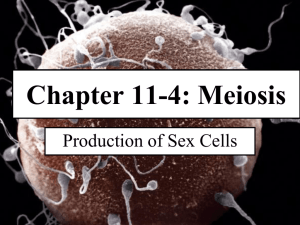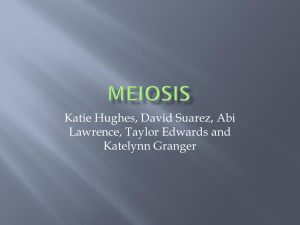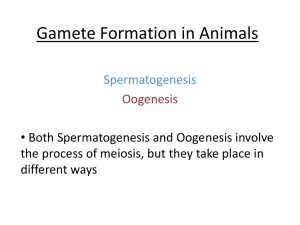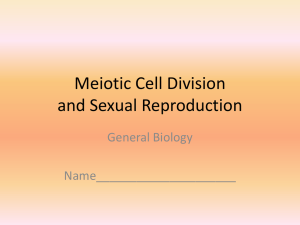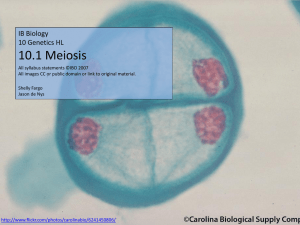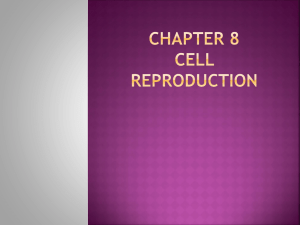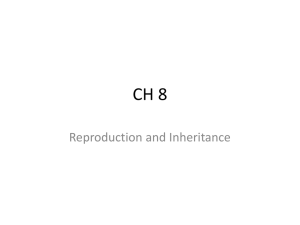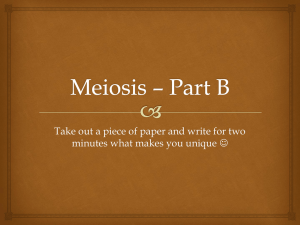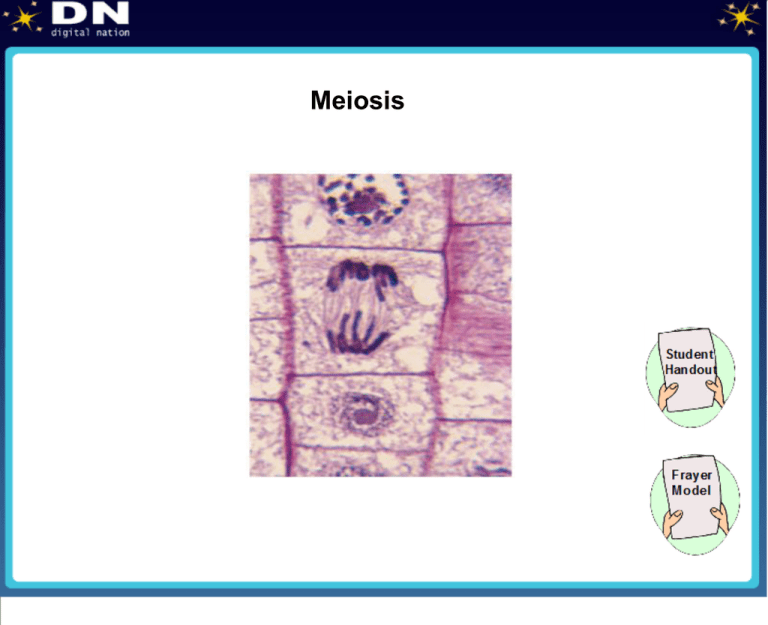
Meiosis
Lesson Objective
The student will describe the process of meiosis.
Subobjective 1: The student will describe how haploid cells develop into mature gametes.
Subobjective 2: The student will compare autosomes to sex chromosomes and body cells
to sex cells.
Subobjective 3: The student will compare and contrast meiosis I and meiosis II.
Vocabulary Overview
1. Gamete
2. Fertilization
3. Meiosis
4. Sperm
5. Egg
Ticket In!
Give an example of a haploid cell.
How is a body cell different than a sex cell?
List one similarity and one difference between mitosis and meiosis.
Click the numbers
Anticipation Guide
Meiosis produces genetically identical cells.
Diploid cells have twice as many chromosomes
as haploid cells.
The autosomes determine the sex of an
individual.
Crossover occurs in Meiosis I only.
Meiosis reduces the number of chromosomes
in a cell.
Erase in the statement boxes
Frayer Model
Fill in each box with the relevant information for the given vocabulary word.
• Sex cells
• Contain DNA
• The cells that pass information
onto offspring
• Females - eggs
• Males - sperm
Erase inside the boxes
Frayer Model
Fill in each box with the relevant information for the given vocabulary word.
• The female gamete produced
by the ovaries
• Used in reproduction
• Haploid
• One egg arises from meiosis
• Ovum
Erase inside the boxes
Frayer Model
Fill in each box with the relevant information for the given vocabulary word.
• The male gamete produced
in the testes
• Used in reproduction
• Haploid
• Four sperm arise from meiosis
• Sperm cell
Erase inside the boxes
Frayer Model
Fill in each box with the relevant information for the given vocabulary word.
• The fusion of an egg
and a sperm
• Human egg and
sperm combine.
Erase inside the boxes
• The nuclei in the egg
and sperm fuse.
Frayer Model
Fill in each box with the relevant information for the given vocabulary word.
• The process of dividing
diploid cells into haploid cells
• Creation of haploid gametes
Erase inside the boxes
• Produces genetically identical cells
• Essential for sexual reproduction
• Takes place only at certain times
during the life cycle
Body Cells vs. Gametes
Body Cells
Most of the cells that
comprise your body
Contain a complete
set of chromosomes
Not passed onto offspring
i.e.: skin cells, brain cells,
eyeball cells, kidney cells
Of which type of cell is the brain comprised?
Sex Cells (Gametes)
Only the cells that make up
eggs and sperm
Contain half of a set
of chromosomes
These cells are passed onto
your children.
i.e.: sperm, eggs
click the pictures
Homologous Chromosomes
If you had 23 pairs of socks, how many individual
socks would you have?
The same is true for the chromosomes in your cells.
Are homologous chromosomes completely identical to each other?
Why or why not?
46
Homologous Chromosomes
Scientists have created a chart that numbers these chromosomes.
Erase in the box.
What do the different colors on the chromosomes represent?
Click here
Autosomes
Chromosome pairs 1-22 are not related to the sex of the individual.
These chromosomes are responsible for the development
and functionality of the organism. They are autosomes.
Click here
Circle the autosomes.
Sex Chromosomes
The 23rd and final pair of chromosomes
is called the sex chromosomes.
These are not homologous chromosomes.
The sex (male or female) and development of sexual characteristics are determined by this set.
XX = Female
X: larger sex chromosome
contains many genes not
directly related to sex
characteristics
XY = Male
Y - smaller sex chromosome
responsible for the
development of male sexual characteristics such as
the testes
Diploid vs. Haploid
Haploid (n):
The cell has 1
copy of each
chromosome
Diploid (2n):
The cell has 2
copies of each chromosome
(homologous chromosomes
i.e.: sex cells
i.e.: body cells
Importance of Meiosis
Meiosis reduces the number of chromosomes.
The number of
chromosomes is
unique to each
species.
Why do our sex cells have to be haploid?
To ensure the correct number of chromosomes
in the offspring
This allows for variation
within the same species
Click here to
see examples.
Circle the equation that best
represents meiosis.
1+1=1
1/2 + 1/2 = 1
Chromosomes vs. Chromatids
When learning about meiosis, you will hear
about chromosomes and chromatids.
Do you know the difference?
Each sister chromatid contains the information from just one parent.
These are attached at the center by a centromere.
Meiosis I
Meiosis I: separation of homologous chromosomes
Erase above the line.
End Result = 2 diploid cells
Prophase I
Nucleus breaks down and centrioles
start to produce spindle fibers.
Duplicated chromosomes
condense and pair up.
Crossover occurs and genes are exchanged between homologous
chromosomes
Can you spot the
cell in Prophase I?
Answer:
F
Crossing Over
Click on the globe to watch an educational video online.
Metaphase I
Homologous chromosomes
attach to spindle fibers.
These chromosomes are aligned
along the center so that each side
has chromosomes from both parents
Chromosomes are aligned randomly
to ensure genetic variability.
Can you spot the cell
in Metaphase I?
Anaphase I
Homologous chromosomes are pulled
apart toward each side of the cell.
Sister chromatids stay attached.
Can you spot the cell
in Anaphase I?
Answer: H
Telophase I
Spindle fibers break down.
Nuclear envelope reforms
to contain chromatids.
Cytoplasm is divided (cytokinesis).
Can you spot the cell
in Telophase I?
Meiosis II
Meiosis II: separation of sister chromatids
Erase above the line.
End
Result
- 4Result
cells
click here
Same process as
Prophase I
However, there is
no crossover.
Can you spot the cell
in Prophase II?
Answer: I
Metaphase II
Same process as Metaphase I.
This time, spindle fibers
align sister chromatids.
Can you spot the cell
in Metaphase II?
Answer: D
Anaphase II
Sister chromatids are separated
into each side of the cell.
Can you spot the cell
in Anaphase II?
Answer: B
Metaphase II
Telophase II
Same process as
Telophase I.
During cytokinesis,
the cytoplasm is divided.
Can you spot the cell
in Telophase II?
Which would show the
cell after cytokinesis?
Answer: C & A
Meiosis I vs. Meiosis II
Write the correct term on the line. Then match the picture with the phase.
Metaphase I:
Prophase II:
Anaphase II:
Telophase I:
Prophase I:
Telophase II:
Metaphase II:
Anaphase I:
Development of Gametes
Meiosis produces gametes that are unable to be fertilized.
Therefore, they must go through more changes.
Spermatogenesis:
maturation of sperm
Oogenesis:
maturation of an egg
An egg will always have an X chromosome and a sperm will have an
X or a Y. Which gamete is responsible for determining the sex of a child?
Review Questions
Which row in the chart below indicates the correct process for each event indicated?
A
1
B
C
3
2
D
4
Wrap Up
Explain why it is important for gametes to be haploid cells.
Teacher's Resources
Mitosis Vs .Meiosis Animation
Meiosis Animation
Mitosis & Meiosis Hangman


